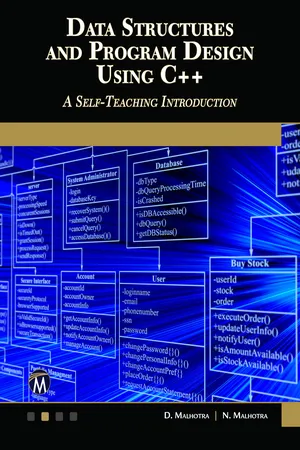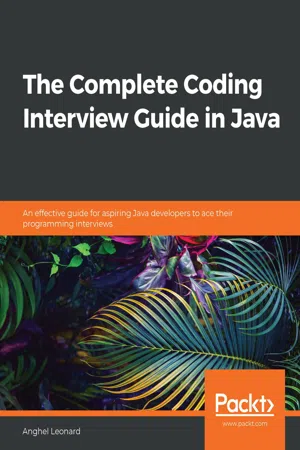Computer Science
Java Queue Interface
Java Queue Interface is a collection interface that represents a queue data structure. It extends the Collection interface and provides methods for adding, removing, and examining elements in a queue. The Queue interface is implemented by several classes in the Java Collections Framework, including LinkedList and PriorityQueue.
Written by Perlego with AI-assistance
Related key terms
Related key terms
1 of 4
Related key terms
1 of 3
6 Key excerpts on "Java Queue Interface"
- eBook - ePub
Data Structures and Program Design Using Java
A Self-Teaching Introduction
- D. Malhotra, N. Malhotra(Authors)
- 2020(Publication Date)
- Mercury Learning and Information(Publisher)
5QUEUES
5.1 Introduction
A queue is an important data structure which is widely used in many computer applications. A queue can be visualized with many examples from our day-to-day life with which we are already familiar. A very simple illustration of a queue is a line of people standing outside to enter a movie theatre. The first person standing in the line will enter the movie theatre first. Similarly, there are many daily life examples in which we can see the queue being implemented. Hence, we observe that whenever we talk about a queue, we see that that the element at the first position will be served first. Thus, a queue can be described as a FIFO (first in, first out) data structure; that is, the element which is inserted first will be the first one to be taken out. Now, let us discuss more about queues in detail.5.2 Definition of a Queue
A queue is a linear collection of data elements in which the element inserted first will be the element taken out first (i.e., a queue is a FIFO data structure).A queue is an abstract data structure, somewhat similar to stacks. Unlike stacks, a queue is open on both ends. A queue is a linear data structure in which the first element is inserted on one end called the REAR end (also called the tail end), and the deletion of the element takes place from the other end called the FRONT end (also called the head).One end is always used to insert data and the other end is used to remove data.Queues can be implemented by using arrays or linked lists. We will discuss the implementation of queues using arrays and linked lists in this section.Practical Application- A real-life example of a queue is people moving on an escalator. The people who got on the escalator first will be the first ones to step off of it.
- Another illustration of a queue is a line of people standing at the bus stop waiting for the bus. Therefore, the first person standing in the line will get into the bus first.
- eBook - ePub
- D. Malhotra, N. Malhotra(Authors)
- 2019(Publication Date)
- Mercury Learning and Information(Publisher)
5QUEUES
In This Chapter• Introduction• Definition of a queue• Implementation of a queue• Operations on queues• Types of queues• Applications of queues• Summary• Exercises5.1Introduction
A queue is an important data structure which is widely used in many computer applications. A queue can be visualized with many examples from our day-to-day life with which we are already familiar. A very simple illustration of queue is a line of people standing outside to enter a movie theater. The first person standing in the line will enter the movie theater first. Similarly, there are many daily life examples in which we can see the queue being implemented. Hence, we observe that whenever we talk about a queue, we see that that the element at the first position will be served first. Thus, a queue can be described as a FIFO (first in, first out) data structure; that is, the element which is inserted first will be the first one to be taken out. Now, let us discuss more about queues in detail.5.2Definition of a Queue
A queue is a linear collection of data elements in which the element inserted first will be the element taken out first (i.e., a queue is a FIFO data structure). A queue is an abstract data structure, somewhat similar to stacks. Unlike stacks, a queue is open on both ends.Queues can be implemented by using arrays or linked lists. We will discuss the implementation of queues using arrays and linked lists in this section.A queue is a linear data structure in which the first element is inserted on one end called the REAR end (also called the tail end), and the deletion of the element takes place from the other end called the FRONT end (also called the head). One end is always used to insert data and the other end is used to remove data.Practical Application: •A real-life example of a queue is people moving on an escalator. The people who got on the escalator first will be the first ones to step off of it. - eBook - ePub
Data Structures and Program Design Using Python
A Self-Teaching Introduction
- D. Malhotra, N. Malhotra(Authors)
- 2020(Publication Date)
- Mercury Learning and Information(Publisher)
CHAPTER 5QUEUES5.1 INTRODUCTIONA queue is an important data structure that is widely used in many computer applications. A queue can be visualized with many examples from everyday life. A very simple illustration of a queue is a line of people standing outside a movie theater. The first person standing in the line will enter the movie theatre first. We observe that whenever we talk about a queue, we see that that the element in the first position is served first. Thus, a queue can be described as a FIFO (First-In, First-Out) data structure; that is, the element that is inserted first will be the first one to be taken out.5.2 DEFINITION OF A QUEUEA queue is a linear collection of data elements in which the element inserted first is the element taken out first (i.e., a queue is a FIFO data structure). A queue is an abstract data structure, somewhat similar to stacks. Unlike stacks, a queue is open on both ends. A queue is a linear data structure in which the first element is inserted on one end, called the REAR end (also called the tail end), and the deletion of the element takes place from the other end, called the FRONT end (also called the head). One end is always used to insert data and the other end is used to remove data.Queues can be implemented by using arrays or linked lists. We discuss the implementation of queues using arrays and linked lists in this section.Practical Application:● A real-life example of a queue is people moving on an escalator. The people who got on the escalator first will be the first ones to step off of it.● Another illustration of a queue is a line of people standing at the bus stop waiting for the bus. Therefore, the first person standing in the line will get into the bus first.5.3 IMPLEMENTATION OF A QUEUEQueues can be implemented using two data structures:5.3.1 Implementation of Queues Using Arrays1. arrays/lists2. linked listsQueues can be easily implemented using arrays. Initially, the front end (head) and the rear end (tail) of the queue point at the first position or location of the array. As we insert new elements into the queue, the rear keeps on incrementing, always pointing to the position where the next element will be inserted, while the front remains in the first position. - eBook - ePub
The Complete Coding Interview Guide in Java
An effective guide for aspiring Java developers to ace their programming interviews
- Anghel Leonard(Author)
- 2020(Publication Date)
- Packt Publishing(Publisher)
MyStack .Queues in a nutshell
A queue is a linear data structure that uses the First-In-First-Out (FIFO ) principle. Think of people standing in a queue to buy stuff. You can also imagine ants that are walking in a queue formation.So, technically speaking, the elements are removed from the queue in the same order that they are added. In a queue, the elements added at one end referred to as the rear (this operation is known as the enqueue operation) and removed from the other end referred to as the front (this operation is known as the dequeue or poll operation).The common operations in a queue are as follows:- enqueue(E e) : Adds an element to the rear of the queue
- E dequeue() : Removes and returns the element from the front of the queue
- E peek() : Returns (but doesn't remove) the element from the front of the queue
- boolean isEmpty() : Returns true if the queue is empty
- int size() : Returns the size of the queue
- boolean isFull() : Returns true if the queue is full
Unlike an array, a queue does not provide access to the n th element in constant time. However, it does provide constant time for adding and removing elements. A queue can be implemented on top of an array or even on top of a linked list or a stack (which is built on top of an array or a linked list). The implementation used here is based on an array and is named MyQueue - eBook - ePub
- Oswald Campesato(Author)
- 2023(Publication Date)
- Mercury Learning and Information(Publisher)
7QUEUES AND STACKSWHAT IS A QUEUE?T his chapter introduces you to queues and stacks that were briefly introduced in Chapter 4 in the section pertaining to linear data structures.The first part of this chapter explains the concept of a queue, along with Java code samples that show you how to perform various operations on a queue. Some of the code samples also contain built-in functions for queues, such as isEmpty() , isFull() , push() , and dequeue() .The second part of this chapter explains the concept of a stack, along with Java code samples that show you how to perform various operations on a stack. In addition, you will see code samples for finding the largest and smallest elements in a stack and reversing the contents of a stack.The final section contains three interesting tasks that illustrate the usefulness of a stack data structure. The first task determines whether or not a string consists of well-balanced round parentheses, square brackets, and curly braces. The second task parses an arithmetic expression that can perform addition, subtraction, multiplication, or division, as well as any combination of these four arithmetic operations. The third task converts infix notation to postfix notation.A queue consists of a collection of objects that uses the FIFO (first-in-first-out) rule for inserting and removing items. By way of analogy, consider a toll booth: the first vehicle that arrives is the first vehicle to pay the necessary toll, and it’s also the first vehicle to exit the tool booth. As another analogy, consider customers standing in a line (which in fact is a queue) in a bank: the person at the front of the queue is the first person to approach an available teller. The “back” of the queue is the person at the end of the line (i.e., the last person).A queue has a maximum size MAX - eBook - ePub
- Oswald Campesato(Author)
- 2023(Publication Date)
- Mercury Learning and Information(Publisher)
7QUEUES AND STACKST his chapter introduces you to queues and stacks that were briefly introduced in Chapter 4 in the section pertaining to linear data structures.The first part of this chapter explains the concept of a queue, along with Java code samples that show you how to perform various operations on a queue. Some of the code samples also contain built-in functions for queues, such as isEmpty() , isFull() , push() , and dequeue() .The second part of this chapter explains the concept of a stack, along with Java code samples that show you how to perform various operations on a stack. In addition, you will see code samples for finding the largest and smallest elements in a stack and reversing the contents of a stack.The final section contains three interesting tasks that illustrate the usefulness of a stack data structure. The first task determines whether or not a string consists of well-balanced round parentheses, square brackets, and curly braces. The second task parses an arithmetic expression that can perform addition, subtraction, multiplication, or division, as well as any combination of these four arithmetic operations. The third task converts infix notation to postfix notation.WHAT IS A QUEUE?
A queue consists of a collection of objects that uses the FIFO (first-in-first-out) rule for inserting and removing items. By way of analogy, consider a toll booth: the first vehicle that arrives is the first vehicle to pay the necessary toll and also the first vehicle to exit the tool booth. As another analogy, consider customers standing in a line (which in fact is a queue) in a bank: the person at the front of the queue is the first person to approach an available teller. The “back” of the queue is the person at the end of the line (i.e., the last person).A queue has a maximum size MAX
Index pages curate the most relevant extracts from our library of academic textbooks. They’ve been created using an in-house natural language model (NLM), each adding context and meaning to key research topics.
Explore more topic indexes
Explore more topic indexes
1 of 6
Explore more topic indexes
1 of 4





